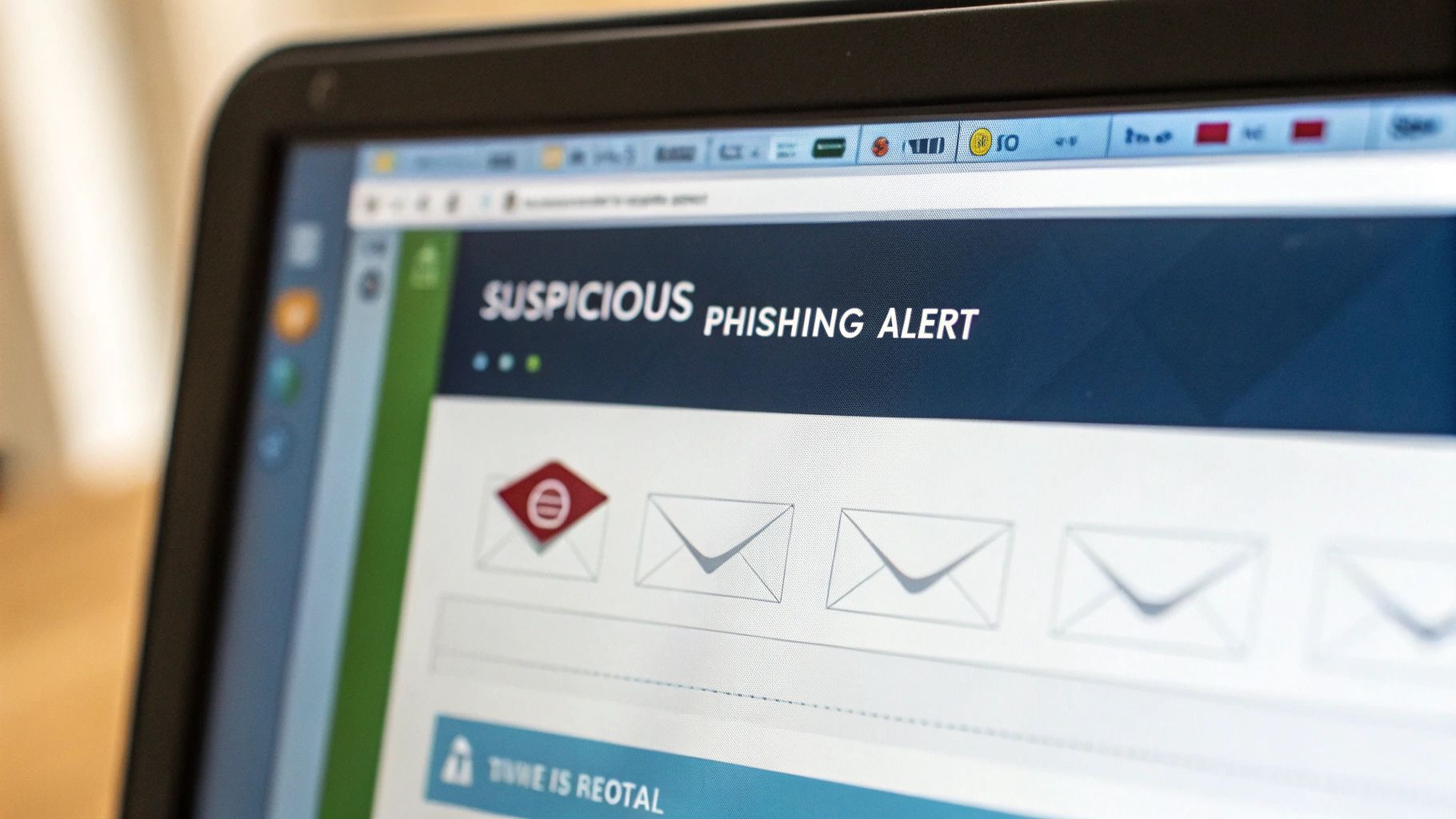Essential Cybersecurity for Small Businesses: Your Step-by-Step Protection Guide
Understanding Why Your Small Business Is a Prime Target

If you run a small business, you might think your company is too small to catch a hacker's eye. But that's a dangerous way of thinking. The reality is that small businesses are actually prime targets for cybercrime – and protecting your business isn't optional anymore, it's essential.
Why Cybercriminals Target Small Businesses
Think of it this way: Hackers often go after small businesses because they're easier targets than large corporations. Most small companies simply don't have the money or staff to build strong security systems. For hackers, this creates a perfect opportunity. Instead of trying to breach one heavily-guarded large company, they can target several smaller businesses at once. While each attack might yield less money, hitting multiple targets makes it worthwhile – and less likely to draw attention from law enforcement.
Common Vulnerabilities Exploited in Small Businesses
Small businesses often leave themselves open to attack without realizing it. When you're focused on growing your business, security can take a back seat. Here are the weak spots hackers commonly exploit:
- Weak Passwords: Many employees use simple passwords or reuse them across different accounts. This makes it easy for hackers to break in through basic password-cracking methods.
- Outdated Software: Skipping those annoying software updates is tempting, but those updates often fix security holes that hackers know about and actively exploit.
- Lack of Employee Training: Your team might accidentally click on fake emails or download malicious files simply because they don't know better. Without proper training, staff members can unknowingly let attackers into your system.
- Basic Security Missing: Many small businesses skip even basic protection like firewalls or security monitoring. This leaves their networks wide open, making it simple for criminals to steal data or plant harmful software.
Shifting From Reactive to Proactive Cybersecurity
Here's a sobering fact: 60% of small businesses close within six months of a cyber attack. You can't afford to wait until after an attack to think about security. Instead of scrambling to fix problems after they happen, you need to prevent them in the first place.
Good security means taking action before problems arise. Here's what that looks like:
- Regular Security Checks: Look for weak spots in your system before hackers do. Fix problems as you find them.
- Basic Security Tools: Put basic protections in place like firewalls, anti-virus software, and two-step verification for logins.
- Emergency Plans: Create clear steps for what to do if you get hacked. This helps you respond quickly and limit the damage.
These steps might seem like extra work now, but they're far less painful than dealing with a cyber attack. Making security a priority isn't just about protecting your business – it's about making sure it stays in business at all.
The Real Impact of Cyber Attacks on Your Bottom Line
When a cyber attack hits your small business, it affects more than just your data – it threatens your entire operation. The fallout from a security breach can echo through your business for months or even years, affecting everything from daily operations to long-term growth potential. Let's explore what a cyber attack truly costs small businesses beyond the immediate crisis.
The Financial Fallout: Direct and Indirect Costs
The money lost in a cyber attack goes far beyond the obvious expenses. While you'll face immediate costs like hiring security experts, recovering systems, and paying legal fees, the hidden costs often pack a bigger punch. Business disruptions mean lost revenue, damaged reputation drives away customers, and employee productivity takes a hit as staff deal with compromised systems. For small businesses with tight margins, these expenses can be devastating. Recent data shows small businesses paid around $8,300 on average to recover from cyber attacks in 2023 – though many faced much steeper bills.
Reputational Damage: The Lingering Effect
A cyber attack leaves a lasting stain on your business reputation that's hard to scrub away. When customers learn their data was exposed, many lose faith and take their business elsewhere. Bad press spreads quickly, making it tough to attract new customers to replace those who left. The numbers tell the story – 55% of consumers say they avoid doing business with companies that have suffered data breaches. This loss of trust can haunt your brand long after the technical issues are fixed.
Operational Disruptions: The Domino Effect
When cyber criminals strike, they can bring your entire operation grinding to a halt. Take ransomware attacks – they lock you out of crucial systems, preventing you from serving customers, processing orders, or even sending emails. This downtime bleeds money and productivity. Even after getting systems back online, disruptions continue as you beef up security and iron out lingering technical problems. For perspective, half of small and mid-sized businesses needed 24+ hours just to restore basic operations after an attack.
Case Study: The Ripple Effect of a Ransomware Attack
Picture this real scenario: A small online store gets hit with ransomware. Their website goes dark, customer data gets locked away, and the criminals demand payment. While the ransom itself hurts, it's just the beginning. Every hour offline means lost sales. Worried customers post negative reviews about their exposed data. The store has to invest heavily in new security measures they hadn't budgeted for. One attack creates waves that crash through every part of the business.
Protecting Your Bottom Line: Proactive Cybersecurity for Small Businesses
The harsh reality is that cyber attacks can be fatal for small businesses – 60% close within six months of a breach. But this doesn't mean you're helpless. While good security requires investment, it costs far less than recovering from an attack. Basic steps like employee training and essential security measures significantly reduce your risk. Think of cybersecurity not as an expense, but as insurance for your business's future. Taking action now could mean the difference between thriving and closing your doors after an attack.
Building Your Essential Security Framework
Creating strong cybersecurity doesn't require a huge budget or dedicated IT team. The key is establishing basic safeguards that match your specific business needs and risks. By identifying your main vulnerabilities and putting core protections in place, you can build effective defenses against common cyber attacks.
Essential Security Layers for Small Businesses
Think of protecting your business like building a house – you start with a solid foundation and add layers of security. Here's what that means for your company:
-
Firewall Protection: This acts as the security guard between your internal network and external threats. A firewall watches all network traffic going in and out, blocking unauthorized access. Without this basic protection, malware and hackers can easily enter your systems.
-
Antivirus and Anti-malware Software: These tools constantly check your devices and networks for harmful programs like viruses, ransomware, and spyware. When threats are found, they're isolated or removed before causing damage. Regular updates are vital to stay protected against new threats.
-
Strong Passwords and Multi-Factor Authentication (MFA): Simple passwords are like leaving your door unlocked. Make sure employees use strong, unique passwords and add MFA wherever possible. MFA requires multiple ways to verify identity, so even if hackers get a password, they still can't access your accounts.
-
Regular Software Updates: Old software versions often have security flaws that attackers can exploit. By keeping your systems, apps and security tools current, you close these gaps. This simple step blocks many common attack methods.
-
Data Backups and Recovery Plan: Losing data can shut down your business. Regular backups mean you can quickly restore everything if you're hit by an attack, equipment failure, or disaster. Create a clear plan for getting systems back up and running to minimize downtime.
Prioritizing Your Security Investments
While complete protection is ideal, most small businesses need to focus limited resources on their biggest risks. For example, if you handle sensitive customer data, start with strong encryption and access controls. If employees work remotely, secure VPNs and mobile device security should be top priorities.
This table shows which security measures matter most for different business types:
| Security Measure | E-commerce | Service-Based | Brick-and-Mortar |
|---|---|---|---|
| Firewall | High | High | Medium |
| Antivirus/Anti-malware | High | High | High |
| Strong Passwords/MFA | High | High | High |
| Software Updates | High | High | High |
| Data Backups/Recovery | High | High | Medium |
| Data Encryption | High | Medium | Low |
| VPN | Medium | High | Low |
| Mobile Device Security | Medium | High | Low |
Building a Culture of Security Awareness
Technical tools alone aren't enough – your team needs to understand security basics. Regular training helps employees spot fake emails, avoid dangerous links, and report potential threats. Make security part of your company culture through ongoing education and clear policies.
By combining essential security measures with employee awareness, you create strong protection that lets you focus on growing your business. Remember that security isn't a one-time project but an ongoing process of monitoring, updating, and improving your defenses as threats evolve.
Creating Your Smart Security Budget
A solid cybersecurity plan needs proper financial backing, but that doesn't mean overspending. The key is making smart choices about where to invest your security dollars. Let's walk through how to build a budget that keeps your small business protected without breaking the bank.
Defining Your Security Spending Priorities
Start by looking at what needs protecting most in your business. If you run an online store, you'll want to focus on securing customer payment data and personal information. For businesses with remote teams, protecting remote access and employee devices becomes the priority. By identifying your specific risks first, you can direct money where it matters most.
The cost of cleaning up after a cyber attack far outweighs prevention costs. Small businesses spend on average $8,300 recovering from cyber incidents, according to 2023 data. Those expenses come from lost business, system repairs, and damage to customer trust. This shows why investing in protection early makes good business sense.
Cost-Effective Solutions for Maximum Protection
Good security doesn't always mean big spending. Many basic but powerful protections cost little or nothing. Using strong passwords and two-factor authentication greatly improves account security at no cost. Regular software updates also fix security holes for free. Even on a tight budget, these simple steps make a real difference.
Free and open-source security tools can help stretch your budget further. Basic antivirus programs and firewalls are available at no cost and provide solid starting protection. This lets you save money for other important needs like staff training or specialized security software.
Avoiding Common Budget Pitfalls
Many businesses make the mistake of treating security as a one-time purchase. In reality, it needs ongoing investment as threats keep changing. Your budget should plan for regular security reviews, software updates, and continuing employee education.
Another common oversight is not investing enough in staff training. Your employees are your first defense against scam emails and social engineering tricks. Studies show human error causes 95% of security problems. That's why regular security awareness training is worth every penny spent.
Securing Executive Buy-In
When asking management to approve security spending, focus on the business benefits. Show how good security protects company reputation, prevents costly data breaches, and keeps operations running smoothly. Help them see security as an investment in the company's future, not just an expense.
Back up your budget request with clear numbers and priorities. Explain which solutions you've chosen and why they're cost-effective. This practical approach helps leadership understand the value of protecting the business. Remember – in today's business world, strong security isn't optional – it's essential for long-term success.
Transforming Employees Into Security Champions
While having strong security tools and systems is essential, your employees play the most crucial role in protecting your business from cyber threats. Think of your team as the first line of defense – they need the right knowledge and skills to spot and stop potential attacks before they happen. Building a security-aware culture starts with empowering your employees to become active participants in your company's cyber defense.
Why Employee Training Is Paramount
Picture your employees as individual guards working together to protect your business from intruders. Even the most advanced security systems can fail if an employee accidentally clicks on a malicious link or shares login details with a scammer. The numbers don't lie – human error accounts for 95% of security breaches. This makes proper security training one of the most important investments you can make to protect your business.
Creating Engaging and Effective Training Programs
Let's face it – boring lectures about security policies rarely stick. Instead, focus on making training interactive and memorable for your team.
Here are some proven approaches:
- Simulations: Run regular mock phishing tests to help employees practice spotting suspicious emails. Track who falls for these tests to identify areas needing more training.
- Gamification: Add fun elements like team competitions, quizzes with prizes, and achievement badges to make learning security skills more engaging.
- Microlearning: Break training into short 5-10 minute segments that employees can complete between tasks, rather than long sessions that overwhelm.
- Real-World Examples: Share actual stories of cyber attacks and their impact to show why security matters. Use examples relevant to your industry.
- Interactive Workshops: Get hands-on with activities like spotting phishing red flags, creating strong passwords, and practicing incident response.
Reinforcing Security Habits and Measuring Improvement
One-time training isn't enough – you need ongoing reinforcement to build lasting security habits.
Try these methods:
- Regular Reminders: Send quick security tips and updates about new threats through email or chat. Keep messages brief and actionable.
- Performance Tracking: Monitor how employees do on phishing tests and other security exercises. Use data to adjust training as needed.
- Positive Recognition: Highlight and reward employees who consistently follow good security practices. This motivates others to do the same.
- Personal Coaching: Work one-on-one with employees who need extra help understanding security concepts or implementing best practices.
Overcoming Resistance to Security Training
Some employees may see security training as a hassle that gets in the way of their "real work." Here's how to address common pushback:
- Show the Impact: Explain how security directly affects their job, the company's success, and protection of their own information at work.
- Customize Content: Adapt training examples and scenarios to different roles. What matters to accounting differs from sales or IT.
- Skip the Jargon: Focus on clear, practical guidance rather than technical terms. Make instructions easy to follow.
- Build Into Workflow: Integrate security naturally into daily tasks. For example, make strong passwords and two-factor authentication standard practice.
When you invest in engaging training, regular reinforcement, and addressing employee concerns, you build a strong human shield against cyber threats. This proactive approach works far better than scrambling to react after an incident occurs. Remember – your well-trained employees are your best defense against cyber attacks.
Securing Your Future With Cyber Insurance
Having solid security measures for your small business is essential, and cyber insurance plays a key role in this protection. Getting the right coverage isn't just checking off a requirement – it means carefully evaluating different policies to find one that protects your specific business needs. Think of cyber insurance as your financial backup plan if other security defenses fail.
Understanding the Need for Cyber Insurance
No security system is perfect, even with strong protections in place. The financial impact of recovering from an attack can be devastating – from immediate costs like fixing systems and legal fees to longer-term effects like lost business and damaged reputation. That's exactly what cyber insurance is designed to protect against. The stakes are high – research shows 60% of small businesses close within 6 months after a breach, highlighting why having financial protection is critical.
Navigating the Cyber Insurance Landscape
While cyber insurance options can seem overwhelming at first, understanding the key elements helps you choose the right coverage:
- First-Party Coverage: This protects your business directly, covering costs like data recovery, business interruption, and ransomware payments. It forms the foundation of most cyber policies.
- Third-Party Coverage: This handles claims from others impacted by a breach of your systems. For example, if customer data is exposed through your website, this coverage helps with legal costs and settlements.
- Factors Affecting Premiums: Your rates depend on things like your industry, company size, types of data handled, and current security measures. Similar to how good physical security can reduce traditional insurance costs, strong cyber defenses often lead to better cyber insurance rates.
Deciding What Coverage Your Business Needs
Finding the right cyber policy requires careful evaluation of your specific risks and potential losses. Don't just pick the cheapest option. Key areas to examine:
- Data Breach Response: Will it cover forensics investigation, legal help, and notifying affected parties?
- Business Interruption: Does it compensate for income lost while systems are down? Consider that half of small/medium businesses need over 24 hours to restore basic operations after a breach.
- Cyber Extortion: Are ransomware payments and negotiation costs included?
- Reputational Harm: Will it provide PR and crisis management support to protect your reputation after an incident?
Learning From Real Claim Scenarios
Looking at actual cyber insurance claims provides valuable insights. Many businesses have found their policies didn't fully cover their losses, showing why it's crucial to thoroughly review coverage details and limits beforehand. Understanding these real examples helps you make better choices about your own protection.
When you view cyber insurance as a core part of your overall security strategy and carefully consider your specific needs, you can find a policy that delivers real protection and peace of mind.
Stay informed about the latest in small business cybersecurity. DebugBar.com offers helpful articles and resources on everything from VPNs to AI content strategy. Visit to learn more and strengthen your online security.



Comments
Leave a comment